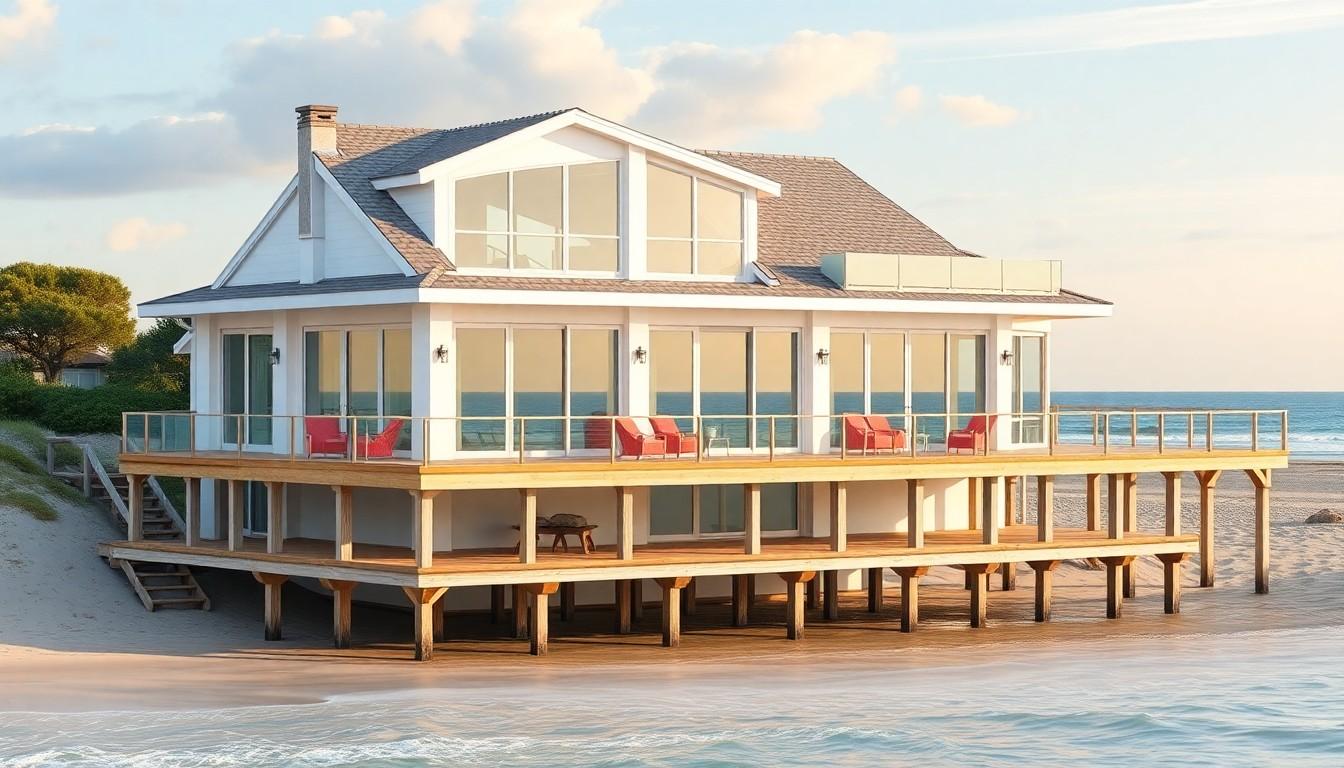Key Takeaways
- Essence of Coastal Living: Coastal home design embodies the tranquility of seaside life, focusing on natural beauty and comfort.
- Color and Material Choices: Light color palettes and sustainable materials enhance serenity and promote a harmonious connection with the environment.
- Seamless Indoor-Outdoor Flow: Large windows and outdoor living areas blur the lines between indoor and outdoor spaces, fostering a relaxed atmosphere.
- Comfort-Focused Furnishings: Furniture should prioritize comfort, utilizing natural materials and soft textiles to create inviting spaces.
- Thoughtful Landscaping: Native, drought-resistant plants and durable hardscaping enhance outdoor spaces while supporting eco-friendly practices.
- Sustainable Practices: Incorporating energy-efficient technologies, low-VOC paints, and water conservation systems minimizes environmental impact and promotes sustainability in coastal design.
Coastal home design captures the essence of seaside living, blending comfort with natural beauty. Inspired by the tranquility of ocean waves and sandy shores, these homes reflect a lifestyle that embraces relaxation and connection with nature. From airy open spaces to light, breezy color palettes, coastal design invites the outside in, creating a serene sanctuary.
Emphasizing sustainable materials and coastal-inspired decor, this style not only enhances aesthetics but also promotes harmony with the environment. Whether it’s a beach cottage or a modern seaside retreat, coastal design offers endless possibilities for creating a home that feels like a vacation every day. Dive into the world of coastal home design and discover how to transform any space into a coastal paradise.
Coastal Home Design
Coastal home design emphasizes comfort and natural beauty, drawing inspiration from seaside environments. This design style incorporates airy spaces, allowing light to flow freely, which fosters a tranquil ambiance. Light color palettes, such as whites, soft blues, and sandy beiges, contribute to a serene atmosphere that invites the outdoors in.
Sustainable materials play a crucial role in coastal design. Options like reclaimed wood and bamboo emphasize environmental harmony while enhancing visual appeal. For instance, reclaimed wood beams add rustic charm, while bamboo flooring offers durability and a nod to eco-friendliness.
Coastal-inspired decor features elements like driftwood accents, nautical motifs, and marine colors. These additions create a relaxed and vacation-like atmosphere, making spaces feel inviting. Furnishings often prioritize comfort, utilizing soft fabrics and plush cushions that encourage relaxation.
Homeowners can achieve a coastal feel in various types of properties, from beach cottages to modern retreats. Regardless of the style, coastal design provides multiple avenues for transforming any space into an idyllic coastal paradise. The integration of nature through large windows and outdoor living areas further blurs the lines between indoor and outdoor spaces, promoting a seamless connection to the surroundings.
Key Elements of Coastal Home Design

Coastal home design relies on specific elements that evoke a relaxed, beach-inspired atmosphere. These elements enhance the connection between indoor and outdoor spaces and contribute to the overall serenity of the environment.
Color Palettes
Color palettes in coastal design feature soft, soothing hues that reflect the natural surroundings. Whites, soft blues, and sandy beiges dominate the palette, creating a light and airy feel. Bright accents, such as coral or seafoam green, add character without overwhelming the senses. Choosing colors that resemble the ocean and beach ensures a tranquil ambiance, allowing homeowners to feel like they’re on vacation year-round.
Architectural Styles
Architectural styles in coastal homes often emphasize openness and fluidity. Key styles include beach cottages, shingle-style homes, and contemporary coastal designs. High ceilings, large windows, and expansive decks enhance natural light and provide stunning views. These designs prioritize outdoor living areas, integrating patios and porches with the indoor space to encourage a seamless flow between environments. Using sustainable materials, such as weather-resistant wood and concrete, boosts durability while maintaining aesthetic appeal.
Interior Design Tips for Coastal Homes
Coastal home interiors embody comfort and simplicity, emphasizing elements that reflect the surrounding environment. Following thoughtful design principles creates a serene and inviting atmosphere.
Furniture Choices
Selecting furniture for coastal homes focuses on comfort and durability. Prioritize pieces made from natural materials, such as rattan or reclaimed wood, that enhance the beach-inspired aesthetic. Choose light-colored or white-washed finishes to maintain an airy feel. Consider sofas and chairs with soft fabrics, like linen or cotton, that promote relaxation. Opt for oversized cushions and slipcovers for easy maintenance and a laid-back appearance. Incorporate multifunctional furniture, such as storage ottomans, to maximize space and organization, creating a cohesive look in open layouts.
Accessorizing with Coastal Elements
Accessorizing with coastal elements infuses personality and character into the space. Use decor items like driftwood pieces, marine-themed art, and seashell displays to create beachy vibes. Incorporate throw pillows and blankets in shades of blues, greens, or sandy beiges to add texture and comfort. Hang framed photographs of seaside scenes or nautical motifs to connect indoor spaces with the coastal environment. Decorate with live plants, such as succulents or sea oats, to enhance the natural feel. Utilize decorative lighting, such as lanterns or pendant lights with a woven design, to evoke a relaxed coastal ambiance.
Outdoor Spaces in Coastal Home Design
Outdoor spaces play a pivotal role in coastal home design, extending living areas into nature and enhancing the connection to the seaside. Thoughtfully designed patios, decks, and landscape elements enrich the coastal experience.
Patios and Decks
Patios and decks function as essential elements in coastal homes, providing areas for relaxation and entertainment. Materials for construction emphasize durability and weather resistance, including composite decking, natural stone, or treated wood.
Features such as built-in seating, outdoor kitchens, and fire pits create inviting spaces for gatherings. Large umbrellas or pergolas offer shade while maintaining an open feel. Incorporating comfortable, weather-resistant furniture enhances usability, encouraging outdoor lounging and dining. Consider integrating features like low-maintenance planters filled with native flora to enhance aesthetic appeal and promote sustainability.
Landscaping Ideas
Landscaping in coastal home design focuses on blending the environment with functionality. Native and drought-resistant plants, such as sea oats or beach grass, align with coastal themes while requiring minimal irrigation.
Hardscaping elements, like stone pathways or beach-themed sculptures, create visual interest and guide inhabitants through outdoor areas. Incorporating sand-friendly materials, like gravel or decomposed granite, allows for practical use in sandy environments.
Incorporating spaces for outdoor activities, such as volleyball courts or fire pits, invites interaction. Use lighting strategically within landscaping to illuminate pathways and highlight features, extending the enjoyment of outdoor spaces into the evening hours.
Sustainability in Coastal Home Design
Sustainability plays a vital role in coastal home design, emphasizing eco-friendly practices and materials. Using sustainable building materials ensures durability and minimal environmental impact.
Materials
- Reclaimed Wood: Employed for floors, beams, and furniture, reclaimed wood reduces waste and provides unique character.
- Bamboo: Utilized for flooring and cabinetry, bamboo grows rapidly and requires less energy for production.
- Low-VOC Paints: Applied for interior and exterior surfaces, low-VOC paints minimize harmful emissions and improve indoor air quality.
Energy Efficiency
- Solar Panels: Installed on rooftops, solar panels harness renewable energy, reducing reliance on fossil fuels.
- Energy-Efficient Windows: Used to enhance insulation, energy-efficient windows help regulate indoor temperatures and reduce heating and cooling costs.
- Smart Home Technology: Integrated systems allow homeowners to monitor and control energy usage, optimizing efficiency.
Water Conservation
- Rainwater Harvesting Systems: Collected rainwater can be used for irrigation and non-potable needs, promoting conservation.
- Native Landscaping: Incorporating drought-resistant plants minimizes water usage while supporting local ecosystems.
- Efficient Irrigation: Utilizing drip irrigation ensures that water reaches the root zone directly, decreasing waste.
Waste Reduction
- Sustainable Sourcing: Prioritizing locally sourced materials lowers transportation emissions and supports regional economies.
- Recycling Programs: Implementing recycling initiatives during construction and renovation reduces landfill waste.
- Repurposed Furnishings: Using vintage or refurbished furniture decreases the demand for new products, promoting sustainability.
Coastal home design can blend aesthetics with stewardship of the environment, creating spaces that are not only beautiful but also crafted for longevity and ecological responsibility.
Unique Blend Of Comfort And Serenity
Coastal home design offers a unique blend of comfort and serenity that resonates with those who cherish seaside living. By incorporating light color palettes and sustainable materials, homeowners can create spaces that reflect the beauty of nature while promoting environmental responsibility.
The emphasis on airy layouts and seamless indoor-outdoor connections enhances the overall experience, inviting the tranquility of the coast into everyday life. With thoughtful decor choices and functional outdoor areas, it’s possible to cultivate a relaxed atmosphere that feels like a permanent vacation.
Exploring coastal design principles can transform any space into a personal retreat, allowing the essence of the beach to inspire daily living.
